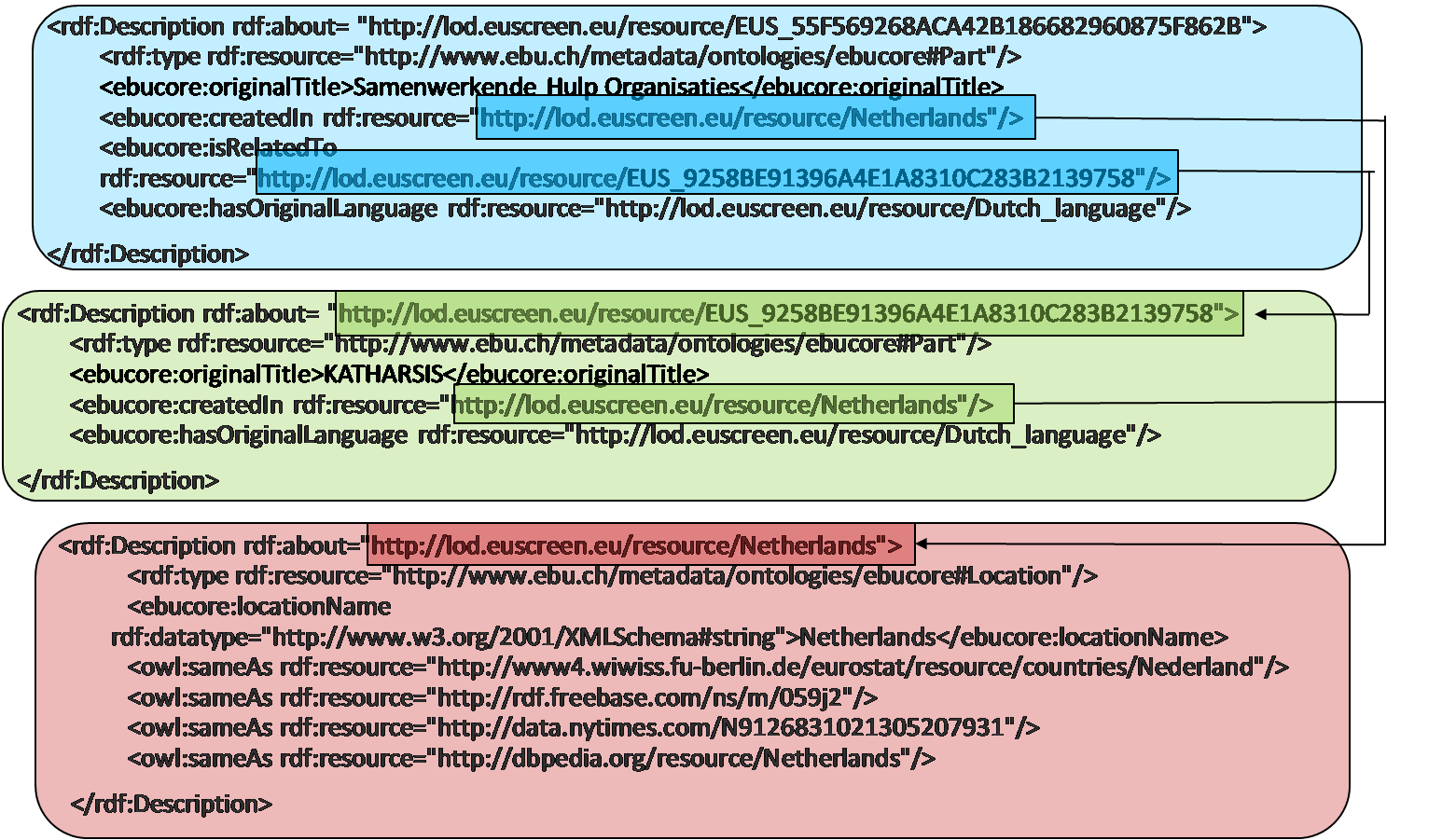
EUscreen Linked Open Data Pilot
Television content is regarded as a vital component of Europe's heritage, collective memory and identity - all our yesterdays - but it remains difficult to access. EUscreen project aims at the creation of a representative collection of television programs, secondary sources and articles permitting in this way access to students, scholars and the general public. The main use cases for this content inlude learning, research, leasure and creative reuse. The lod.euscreen.eu/resource/ pilot is an initial attemp of making the EUscreen content availiable as Linked Open Data on the web. It allows users not only to access and retrieve metadata from the EUScreen content,via standard Web technologies, but also to discover relevant data within the multitude of the available content and even to implement applications that integrate data from EUScreen collection.
The data is represented using the EBU Core ontology and the described resources are addressable and dereferencable by their URIs - for instance, http://lod.euscreen.eu/resource/EUS_55F569268ACA42B186682960875F862B leads either to an HTML page on the EUscreen portal for the object it identifies or to raw, machine-processable data on this object.
Disclaimer: lod.euscreen.eu/resource/ is currently in pilot stage, and can thus be changed at any moment! Your feedback is more than welcome, and may lead to updates in the prototype service.
EUscreen Content
The multidisciplinary nature of the EUscreen project is mirrored in the composition of the socio-technical nature of the consortium; comprising of 20 collection owners, technical enablers, legal experts, educational technologists and media historians of 20 countries.
In collaboration with leading television historians EUscreen has defined a content selection policy, divided into three strands:
- Historical Topics: 14 important topics in history of Europe in the 20th Century (70% of content);
- Comparative Virtual Exhibitions: two specially devised topics that explore more specialised aspects of European history in a more comparative manner (10% of content - include documents, stills, articles);
- Content Provider Virtual Exhibitions: Each content provider selects content supported with other digital materials and textual information on subjects or topics of their own choosing (20 % of content).
lod.euscreen.eu/resource/ currently contains metadata on 12.165 videos that reflect the EUscreeen's content selection policy.
Pilot's Data
The data served by lod.euscreen.eu/resource/ is generated from the metadata EUscreen has harvested using the MINT ingestion platform. More specifically, the providers mapped their metadata using MINT to a harvesting XML schema that was implemented based on EBUcore (an established standard in the area of audiovisual metadata) to achieve interoperability between colections.
In order to publish this data as Linked Data, we have converted it to the Resource Description Framework (RDF) format, and structured it using the EBU Core ontology. More specifically the procudure followed is illustrated in the figure below.

We have implemented a mapping of all the harvesting schemas's elements to classes and properties of the EBU Core ontology. Therefore every provider's instance that has been transformed according to the harvesting schema, is also transformed to an RDF file. This file is then stored in a triplestore repository (the triplestore used is 4store) from where the users can consume data using SPARQL.
In addition to the original data harvested by EUscreen from its data providers, the data served at lod.euscreen.eu/resource/ includes:
- internal links to other videos that are also served by lod.euscreen.eu/resource/.
- semantic enrichment done by NTUA, connecting EUscreen videos to structured representations of places and languages.
The following schema illustrates an excerpt of the resources and the way that they are linked.

Consuming data
lod.euscreen.eu/resource/ is serving data over the HTTP protocol, using established linked data recipes, most notably the use of HTTP URIs as identifiers and entry points into data. Here are some examples of lod.euscreen.eu/resource/ resources:
- http://lod.euscreen.eu/resource/EUS_3C6BD32E727B4B1E807C7CB976A22C8F refers to a video part for which digital resources are available through EUscreen (direct access to data here)
- http://lod.euscreen.eu/resource/DW refers to a provider of a media resource (raw data here)
- http://lod.euscreen.eu/resource/Ukraine refers to the location of a media resource (raw data here)
- http://lod.euscreen.eu/resource/German_language refers to the language used in a media resource (raw data here)
The data can also be consumed through the http://lod.euscreen.eu/sparql sparql endpoint or by using the web interface of the 4store repository.
Contact
Any question, positive feedback or criticism is highly encouraged! Please email us .
Acknowledgements
Coordination and core implementation of lod.euscreen.eu/resource/ are carried out by Nikolaos Simou, Vassilis Tzouvaras and Nasos Drosopoulos, with the support of the EUScreen project. Johan Oomen (Netherlands Institute for Sound and Vision) is the technical director of the project and can be contacted for general enquiries about the project. We also want to thank:
- Jean-Pierre Evain - harvesting schema mapping to EBU Core ontology
- Panos Georgantas - HTTP Redirection